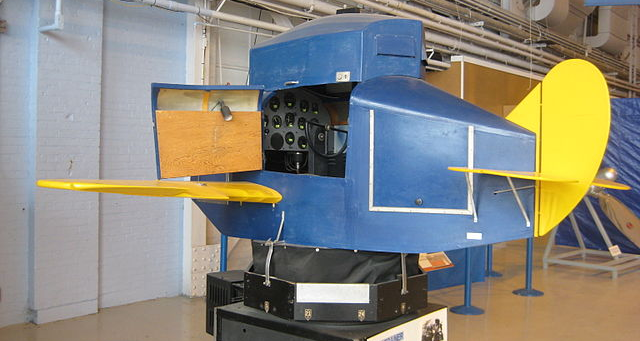Improve your notes (and your life) with two-word phrases
Since my notes are mainly modular, it’s fairly easy to connect two seemingly separate ideas or concepts to create a new one.
I’m intrigued by how important this activity of recombination has been in the history of innovation. For example, in 1929 the American inventor Edwin Link took the vacuum tubes, motors and bellows from his family’s player piano business and reconfigured them to create the Link Trainer. Despite its improbable origin and strikingly bad looks, this was a pioneering flight simulator that during World War 2 trained nearly half a million pilots. And it was made out of organ parts!
As I’ve said before, from fragments you can build a greater whole.
A phrase made only of two juxtaposed words, like ‘flight simulator’, can be a remarkably evocative thing. Choose the right two words and as if by magic, you’ve created a memorable phrase, a new brand, or even the kernel of an innovative technology.

In the social sciences they have been termed sensitizing concepts - which itself is a kind of two-word brand. When they’re working well, such phrases don’t really define something, rather they evoke it. In 1954 the sociologist Herbert Blumer, who originated that phrase, offered some examples from his field:
“mores, social institutions, attitudes, social class, value, cultural norm, personality, reference group, social structure, primary group, social process, social system, urbanization, accommodation, differential discrimination and social control…”
Note how many of these sensitizing concepts are two-word phrases. And note how many of these are still in use today. Pretty much all of them, although I’m not sure ‘differential discrimination’ trips off the tongue…
Such phrases are tremendously evocative. Once you’ve seen a concept like ‘social class’ or ‘cultural norm’, your whole world shifts slightly and it’s hard to un-see it.
Think, too, of some more recent examples, such as ‘tipping point’, ‘bowling alone’, ‘shock doctrine’, ‘atomic habits’. In each of these cases, the ability of the thinker to invent and develop the apposite phrase has effectively made their careers.
If the phrase is strong enough, it brands the originator with no further explanation needed. Even a seemingly awkward phrase, at the right time, can break out into popular recognition. Take ‘intersectional feminism’ - a concept that took a while to get going but then seemed to be everywhere and remains indelibly linked to the name of its originator, Kimberlé Crenshaw.
And then there’s ‘brain rot’, a term first coined in Henry David Thoreau’s 1854 book Walden.
Fully 170 years later, brain rot was named as the Oxford word of the year for 2024. Well, sometimes it takes a moment for an idea to catch on. But in the end, ‘brain rot’ beat several shortlisted words, including ‘dynamic pricing’. Thoreau, incidentally, had an intriguing working method, where he saw his written thoughts as ‘nesteggs’.
In the world of business, the two-word phrase dominates. Think of Home Depot, Mastercard, Microsoft, Netflix, PayPal, FaceBook, Instagram, Bitcoin or even that parody two word brand, TikTok. Ironically perhaps, TikTok is specifically named as having helped make brain rot a discussion point.
There are endless definitive products known by two words cleverly jammed together by marketers in search of a trademark: Band-Aid, Chapstick (or is it lip balm?), bubble wrap, dry ice, fibreglass, ping pong, super glue and super-heroes, video tape, memory stick, cell phone and crock-pot.
Meanwhile, in the German-speaking world, they’ve created a whole culture from compound nouns. It must be the Zeitgeist 1.
Back in the Anglo-sphere, though2, whether its a product (vegan cheese) or a concept (standpoint epistemology), the two-word phrase rules. I’d go so far as to suggest that for any idea to gain an audience it could benefit from the two word treatment.
This ubiquity not only helps with promoting your bright idea, it also helps to show how to discover your bright idea in the first place. Just think of two previously unrelated concepts or objects and join them together. Mostly this won’t work, but sometimes, just sometimes, it will.
I used to live in the United Kingdom3, where the pubs4 sell ‘pork scratchings’. Sadly this is a popular snack, which is just wrong. Although, I will reluctantly concede that if you’re going to eat something called ‘scratchings’, you might do worse than the pork variety.
This illustrates a caution I want to end with: there may only be two words at stake, but you have to choose the right two words. Who ever heard of a car depot, a car stack or a car field? No, it’s obviously a car park.
Unless, that is, it’s obviously a parking station.
I’d love to hear what two-word phrases you’ve coined lately. And if you don’t want to miss out on writingslowly, you are strongly advised to subscribe to my weekly(ish) news letter. It’s like a blog but more fashionable because it’s an email. Now that’s progress!
References:
Blumer, Herbert. 1954. “What is Wrong with Social Theory.” American Sociological Review 18: 3-10.
Davis, Kathy. 2008. ‘Intersectionality as Buzzword: A Sociology of Science Perspective on What Makes a Feminist Theory Successful’. Feminist Theory 9 (1): 67–85. https://doi.org/10.1177/1464700108086364.
Richmond, Michele. The Etymology of Parking. Arnoldia – Volume 73, Issue 2 The Etymology of Parking - Arnold Arboretum PDF
Image by Bzuk (talk) - Own work (Original text: I (Bzuk (talk)) created this work entirely by myself.), Public Domain, Link
Check out my book, Shu Ha Ri: The Japanese Way of Learning, for Artists and Fighters.